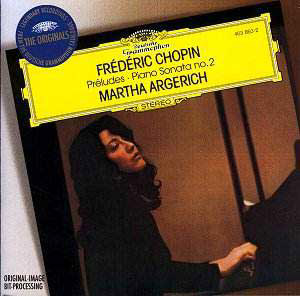 Composer: Frédéric Chopin
Composer: Frédéric Chopin
Works: 24 Preludes op. 28, Prelude in C sharp minor op. 45, Prelude in A flat major op. Posth., Piano Sonata No. 2 in B flat minor op. 35
Performers: Martha Argerich, piano
Recording: Recorded 1974 (sonata), 1975 (28 Preludes), 1977 (op. 45/posth)
Label: Deutsche Grammophon
Chopin’s 24 Preludes, op. 28, stand as a monumental achievement in the piano repertoire, encapsulating the emotional breadth and technical ingenuity that define his compositional voice. Written between 1835 and 1839, these pieces were conceived as a cycle, each prelude corresponding to one of the twenty-four keys of the chromatic scale. This collection not only showcases Chopin’s mastery over the piano but also acts as a microcosm of Romantic expression, ranging from the introspective to the exuberant. Martha Argerich’s interpretation, recorded across the late 1970s, captures the essence of Chopin’s vision while infusing it with her distinctive vigor and interpretative depth.
Argerich’s performance of the Preludes is marked by an unrelenting intensity, a quality that has become synonymous with her pianism. The recording allows her to traverse the spectrum of emotion inherent in these works, often highlighting the contrasts that Chopin so masterfully interwove. Take, for instance, the juxtaposition between Prelude No. 16 in B flat minor and Prelude No. 17 in A flat major. While No. 16 is imbued with a poignant lyricism, No. 17 erupts in a fervent display of technical prowess. Argerich’s ability to maintain the integrity of the cycle while navigating these extremes speaks to her profound understanding of the music’s architecture.
Technical proficiency is a hallmark of Argerich’s interpretation. Her articulation is crisp, and her use of rubato is judicious, allowing for expressive flexibility without sacrificing structural coherence. In the Raindrop Prelude (No. 15), Argerich opts for a more dynamic approach than many of her contemporaries, creating a captivating tension with her rapid shifts in dynamics. This choice, while potentially controversial among purists, serves to infuse the piece with a vibrancy that is often overlooked. The recording quality itself is exemplary, capturing the full spectrum of Argerich’s pianism with clarity and resonance. The sound engineering balances the piano’s brilliance with the subtleties of its timbre, allowing the listener to appreciate the nuances of her performance.
The inclusion of the Piano Sonata No. 2, op. 35, alongside the Preludes further enriches this compilation. Here, Argerich confronts the formidable Funeral March third movement with a more focused approach, yet it is in the outer movements where she truly excels. The Allegro’s tempestuous passages are delivered with deftness, while the Lento reveals her capacity for profound contemplation. Notably, the Trio section within the Scherzo resonates with an almost orchestral breadth, showcasing her ability to project a wide dynamic range.
Comparatively, Argerich’s rendition stands in contrast to the more reserved interpretations of Maurizio Pollini and the frenetic energy of Evgeny Kissin. Pollini’s performances, while technically impeccable, can sometimes come across as emotionally distant, whereas Kissin tends to prioritize speed over the cumulative emotional impact that Argerich achieves. The interpretation choices that Argerich makes, particularly in the interplay between lyricism and virtuosity, elevate her performance to a level that transcends mere technical execution.
Martha Argerich’s recording of Chopin’s 24 Preludes and the accompanying works represents a high watermark in the interpretation of this repertoire. Her unique approach marries emotional depth with technical brilliance, crafting a listening experience that is both stimulating and deeply satisfying. This recording not only honors the spirit of Chopin’s intentions but also redefines them through Argerich’s indelible artistry, making it an essential addition to any serious classical music collection.


